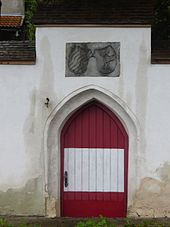Schönwörth Castle
The nice Wörth Castle (the present name Nice Wörth dates from the 19th century) is in the village Niederbreitenbach the municipality of Langkampfen in Kufstein district of Tyrol in Austria .
history
When the country was divided under the Bavarian dukes on March 28, 1255, Langkampfen fell to the Duchy of Upper Bavaria under Duke Ludwig II . Langkampfen was one of the three Schrannen or offices of the Bavarian judicial district of Kufstein . Kufstein only came to Austria after the Landshut War of Succession in 1505. The bishops of Regensburg were also wealthy in Langkampfen. You probably pledged this property with the Schindlberg Castle to Konrad and Friedrich von Freuntsperch . After a settlement dated February 7, 1266, the Freundsberg brothers returned Eigenmen, Vogtei, Hof and Zehnt zu Langkampfen to Bishop Leo von Regensburg .
The tower was first mentioned in a document in 1448, when the Bavarian Duke Heinrich sold the tower to Niederbreitenbach to Hans Ebbser, keeper of Kufstein. The tower was probably built around 1360 by the Lords of Freundsberg, who also built Mariastein at that time . The Lords of Ebbs sold the tower to Marquard Breisacher as early as 1450. After that, the owners changed frequently. First the Praun family owned Niederbreitenbach for a long time (1528–1564), then Georg Praun sold the tower to Georg Ilsung . In 1587 Karl Freiherr von Schurff became the owner of Niederbreitenbach. Two years later he was able to acquire the previous fiefdom as a free property . The name Schönwörth goes back to a residence of the Schurff family in Volders , which was completely destroyed by lightning in 1747. The Schurffs retained the title of “Freiherren von Schönwörth” until they died out (1688). The tower came to Hans Friedrich von Stachlburg , who married the daughter of the last Schurff, via inheritance . In 1747, Simon Felix Freiherr von Crosina inherited the property (as did Mariastein), but sold it to Martin Anton von Cloz in 1773. In 1834 all the goods belonging to the South Tyrolean Cloz family in North Tyrol were sold and Niederbreitenbach came into rural possession on October 14, 1834.
In 1858 the cement manufacturer Alois Kraft from Kufstein bought the tower. The doctor Georg Widmann bought it from him in 1879. In 1886 it went to the Russian Prince Alexander Wladimirowitsch Baratinsky from St. Petersburg . In 1895, Andreas Baron Dipauli von Treuheim, a member of the Reichstag, bought the property. In 1906 the property was sold to the Bavarian Count Max zu Löwenstein-Scharfeneck. In the same year his son, the politician and writer Hubertus Prinz zu Löwenstein was born here. The stone lions at the entrance and some coats of arms on the windows remind of this family. The next owner was Count Strachwitz. In 1925 Consul General Eduard Schüssel bought the castle. This was followed by Mathilde Countess Quadt Isny († May 19, 1967). The current owner is Margit Cornides, the daughter of Countess Quadt Isny.
Schönwörth Palace today
The tower is built from stream stones. The walls are up to 1.2 m thick. The late medieval residential tower from the 12th or 14th century is five storeys high with a crooked hip roof .
The palace underwent various structural changes through Prince Alexander Vladimirovich. A tower and a veranda were added, wagon sheds, horse stables and apartments for the servants were built. Small guest rooms were created in the large square tower. The coat of arms of the new owner was attached to the village side. A new staircase and a covered staircase were added in the form of a round tower. The interior of the castle was also beautifully designed. Prince Baratinsky also bought a small farm next to the castle and had a park laid out; the name Schloss Schönwörth goes back to him .
literature
- Georg Clam Martinic : Castles and palaces in Austria. Landesverlag in Veritas Verlag, Linz 1991, ISBN 3-85214-559-7 .
Web links
- Entry via Schönwörth (Niederbreitenbach) to Burgen-Austria
- 1200 years of Langkampfen
- Schönwörth Castle on austria-forum
- Löwenstein, Hubertus Prince of Löwenstein-Wertheim-Freudenberg
- Hubertus Prince zu Loewenstein (1949) on Spiegel.de
Coordinates: 47 ° 32 '14.7 " N , 12 ° 5' 6.7" E

